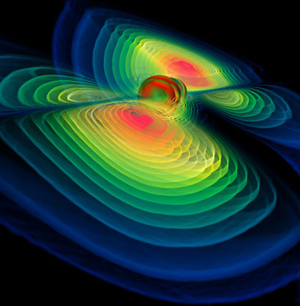The gravitational constant is the proportionality constant used in Newton’s Law of Universal Gravitation, and is commonly denoted by G. This is different from g, which denotes the acceleration due to gravity. In most texts, we see it expressed as:
G = 6.673×10-11 N m2 kg-2
It is typically used in the equation:
F = (G x m1 x m2) / r2 , wherein
F = force of gravity
G = gravitational constant
m1 = mass of the first object (lets assume it’s of the massive one)
m2 = mass of the second object (lets assume it’s of the smaller one)
r = the separation between the two masses
As with all constants in Physics, the gravitational constant is an empirical value. That is to say, it is proven through a series of experiments and subsequent observations.
Although the gravitational constant was first introduced by Isaac Newton as part of his popular publication in 1687, the Philosophiae Naturalis Principia Mathematica, it was not until 1798 that the constant was observed in an actual experiment. Don’t be surprised. It’s mostly like this in physics. The mathematical predictions normally precede the experimental proofs.
Anyway, the first person who successfully measured it was the English physicist, Henry Cavendish, who measured the very tiny force between two lead masses by using a very sensitive torsion balance. It should be noted that, after Cavendish, although there have been more accurate measurements, the improvements on the values (i.e., being able to obtain values closer to Newton’s G) have not been really substantial.
Looking at the value of G, we see that when we multiply it with the other quantities, it results in a rather small force. Let’s expand that value to give you a better idea on how small it really is: 0.00000000006673 N m2 kg-2
Alright, let’s now see what force would two 1-kg objects exert on one another when their geometrical centers are spaced 1 meter apart. So, how much do we get?
F = 0.00000000006673 N. It really doesn’t matter much if we increase both masses substantially.
For example, let’s try the heaviest recorded mass of an elephant, 12,000 kg. Assuming we have two of these, spaced 1 meter apart from their centers. I know it’s difficult to imagine that since elephants are rather stout, but let’s just proceed this way because I want to put emphasis on the significance of G.
So, how much did we get? Even if we rounded that off, we’d still obtain only 0.01 N. For comparison, the force exerted by the earth on an apple is roughly 1 N. No wonder we don’t feel any force of attraction when we sit beside someone… unless of course you’re a male and that person is Megan Fox (still, it’d be safe to assume that the attraction would only be one way).
Therefore, the force of gravity is only noticeable when we consider at least one mass to be very massive, e.g. a planet’s.
Allow me to end this discussion with one more mathematical exercise. Assuming you know both your mass and your weight, and you know the radius of the earth. Plug those into the equation above and solve for the other mass. Voila! Wonder of wonders, you’ve just obtained the mass of the Earth.
You can read more about the gravitational constant here in Universe Today. Want to learn more about a new study that finds fundamental force hasn’t changed over time? There’s also some insights you can find among the comments in this article: Record Breaking “Dark Matter Web” Structures Observed Spanning 270 Million Light Years Across
There’s more about it at NASA. Here are a couple of sources there:
Here are two episodes at Astronomy Cast that you might want to check out as well:
Sources:

